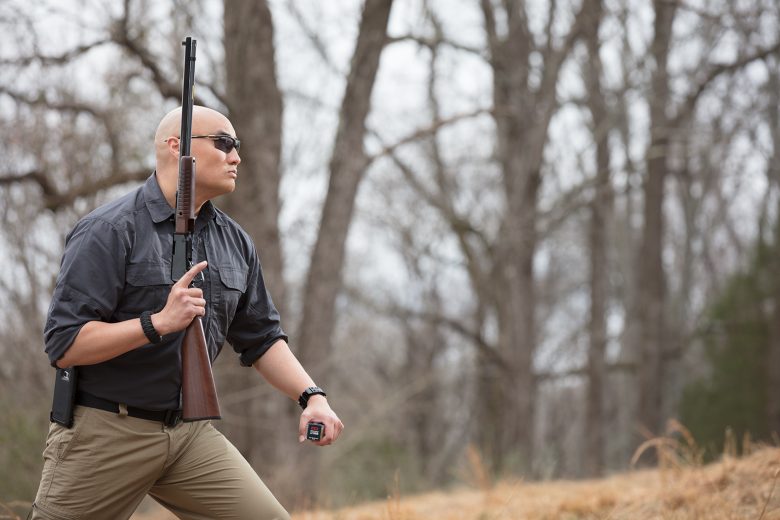Why Buy a Henry Pump Action Octagon .22 WMR?
A Technical Review of the H003TM

I remember looking at Gun Digest Annual as a teenager and wondering why anyone would want a .22 WMR pump action rifle when higher capacity, larger caliber semiautos were available. I also remember buying the cheapest bulk .22 LR ammunition and chuckling at the people who would pay almost as much for a much smaller box of skinny .22 Magnum. Years later, after learning to shoot accurately and knowing the difference between calibers in terms of impact on the target, I came to appreciate both the Henry Pump Action Octagon and the .22 WMR.
Pump or slide action is very efficient: neither hand has to switch position to cycle, pulling back helps absorb some of the recoil, while the forward motion brings the muzzle back on target. With a capacity of 12 rounds in the tube and one in the chamber, the H003TM holds enough for a successful varmint hunt or a defensive encounter.
22 Magnum might sound like a “faster .22LR for a whole lot more money,” but it’s actually much more than that. An elegant cartridge, it achieves significantly higher velocity in a rifle with the same low chamber pressure as the .22 LR. At 100 yards, .22 WMR is as fast as a .22 LR at the muzzle. Comparing 40-grain projectiles, .22 WMR from the 20.5″ octagonal barrel matches the 5.7×28 FN cartridge fired from PS90 carbine. While more expensive than bulk .22 LR, .22 Magnum is less than half the price of the comparable centerfire calibers. And, to compare apples to apples, .22 WMR is only about 50% more than .22 LR ammunition of comparable accuracy. For shooting small varmints across a field, both the improved accuracy and the flatter trajectory with reduced wind drift matter.

Almost all .22 WMR bullets are jacketed, which provides the manufacturers with a lot more options for ensuring high terminal performance. For example, CCI 40gr FMJ fired from a rifle will burn right through the 3/8″ hardened aluminum plate that stops .357 Magnum and 10mm Auto from pistols with 5″ barrels. A 30gr CCI or Hornady ballistic-tipped hollow point will expand massively in a groundhog or a squirrel at ranges where .22 LR would penetrate without expansion. Heavier than most and superbly accurate, Federal 50gr GameShok penetrates well enough for defensive use while grouping under 1.5 MOA. With ammo makers paying more attention to .22 WMR quality control, I’ve had exactly one misfire in about 13 thousand rounds of that caliber fired so far.
The Henry Pump Action Octagon comes with the same semi-buckhorn open sights as other Henry rimfires. With a brass bead up front, these are optimized for speed and work well for a squirrel at 25 yards or a defensive shot on a larger target at 50. Accuracy beyond that is possible but takes more time and skill. Fortunately, the receiver is grooved for 3/8″ rimfire rings, and a Vortex Diamondback 1.75-5x shotgun scope I used for testing is an excellent, reasonably-priced compromise for close range and far. With a 100-yard zero, the mid-trajectory height of a Federal 40gr bullet is only 2 inches. Dead-Hold BDC reticle marks correspond to 125, 160, 190, and 220-yard drops. If you prefer a Picatinny rail for a red dot or a larger scope, a conversion base is available from the Henry store.

Clean and well-balanced, this rifle is easy to shoot accurately off-hand. It is safe to carry in the field with the hammer down at 1/4 cock over a live round. The finish and fit of metal to walnut stock is excellent. Besides zeroing, the only task advised for field use is adding sling swivels and a sling for both carry and support. The octagonal barrel is heavy enough not to deflect from the use of a hasty sling, even though the entire gun is slender at 6 pounds even. While the protrusion of the bolt above the neck of the stock during cycling made me nervous at first, I quickly discovered that the natural hand position with the index finger in line with the trigger keeps the thumb safe.
The Henry H003TM works reliably with all ammunition tested, from 27gr leadless to 50gr soft points. Best accuracy around 1.5 MOA was obtained with 40 and 50 grain Federal, Speer, and CCI ammunition. Although flatter-shooting out to 225 yards, the lighter loads had more wind drift and grouped closer to 3 MOA, making them a better bet at short to medium ranges only. Heavier bullets provide both adequate penetration for coyotes and or hostile humans, and reliable expansion to about .30 caliber past 50 yards. Lighter projectiles fragmented heavily up close and showed limited expansion with excellent penetration further out.
This carbine proved a range favorite for everyone, from seasoned marksmen to newbies. Recoil-averse shooters especially enjoyed the slide action: it was like shooting a shotgun but without punishing recoil. Thanks to the extra energy of the 22WMR cartridge, this fun-maker also serves serious duties with equal competencies.







